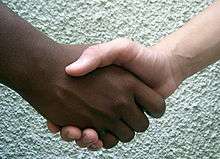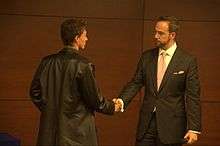Handshake

A handshake is a short ritual in which two people grasp one of each other's like hands, in most cases accompanied by a brief up and down movement of the grasped hands.
Using the right hand is generally considered proper etiquette. Customs surrounding handshakes are specific to cultures. Different cultures may be more or less likely to shake hands, or there may be different customs about how or when to shake hands. Handshakes are known to spread germs.[1][2][3]
History
Archaeological ruins and ancient texts show that handshaking was practiced in ancient Greece as far back as the 5th century BC; a depiction of two soldiers shaking hands can be found on part of a 5th-century BC funerary stele on display in the Pergamon Museum, Berlin (stele SK1708)[4] and other funerary steles like the one of the 4th century BC which depicts Thraseas and his wife Euandria handshaking (see images on the right).[5] The handshake is thought by some to have originated as a gesture of peace by demonstrating that the hand holds no weapon.[6][7][8]
- Pictures: Handshaking depicted on historic artifacts

 Funerary stele of Thrasea and Euandria. Marble, ca. 375-350 BC. Antikensammlung Berlin, Pergamon Museum, 738
Funerary stele of Thrasea and Euandria. Marble, ca. 375-350 BC. Antikensammlung Berlin, Pergamon Museum, 738
Contemporary customs




There are various customs surrounding handshakes, both generically and specific to certain cultures:
The handshake is commonly done upon meeting, greeting, parting, offering congratulations, expressing gratitude, or completing an agreement. In sports or other competitive activities, it is also done as a sign of good sportsmanship. Its purpose is to convey trust, respect, balance, and equality. If it is done to form an agreement, the agreement is not official until the hands are parted [9]
Unless health issues or local customs dictate otherwise, usually a handshake is made with bare hands. However, it depends on the situation.[10]
- In Anglophone countries, in business situations. In casual non-business situations, men are more likely to shake hands than women.[11]
- In The Netherlands and Belgium, handshakes are done more often, especially on meetings.[12][13]
- In Switzerland, it may be expected to shake the women's hands first.[12]
- Austrians shake hands when meeting, often including with children.[12]
- In Russia, a handshake is rarely performed by opposite sexes. Men shaking hands with women can be considered impolite, since hand-kissing is preferred as a ritual for greeting a lady. However, kissing the hand is considered unsuitable for business situations.
- In some countries such as Turkey or the Arabic-speaking Middle East, handshakes are not as firm as in the West. Consequently, a grip which is too firm will be considered as rude.[12] Hand shaking between men and women is not encouraged in countries where the majority religion is Islam.
- Moroccans also give one kiss on each cheek (to corresponding genders) together with the handshake. Also, in some countries, a variation exists where instead of kisses, after the handshake the palm is placed on the heart.[14]
- In China, where a weak handshake is also preferred, people shaking hands will often hold on to each other's hands for an extended period after the initial handshake.[12]
- In Japan, it is appropriate to let the Japanese initiate the handshake, and a weak handshake is preferred.[12]
- In India and several nearby countries, the respectful Namaste gesture, sometimes combined with a slight bow, is traditionally used in place of handshakes. However, handshakes are preferred in business and other formal settings.
- In Norway, where a firm handshake is preferred, people will most often shake hands when agreeing on deals, both in private and business relations.[12]
- In South Korea, a senior person will initiate a handshake, where it is preferred to be weak. It is a sign of respect to grasp the right arm with the left hand when shaking hands. It is also considered rude or disrespectful to have your free hand in your pocket while shaking hands.[12]
- Related to a handshake but more casual, some people prefer a fist bump. Typically the fist bump is done with a clenched hand. Only the knuckles of the hand are typically touched to the knuckles of the other person's hand. Like a handshake the fist bump may be used to acknowledge a relationship with another person. However, unlike the formality of a handshake, the fist bump is typically not used to seal a business deal or in formal business settings.
- The hand hug is a type of handshake popular with politicians, as it can present them as being warm, friendly, trustworthy and honest. This type of handshake involves covering the clenched hands with the remaining free hand, creating a sort of "cocoon".[15]
- Another version popular with politicians is a "photo-op handshake" in which, after the initial grasp both individuals turn to face present photographers and camera men and stay this way for several seconds.
- Scouts will shake hands with their left hand as a gesture of trust, which originated when the founder of the movement, Lord Baden-Powell of Gillwell, then a British cavalry officer, met an African tribesman.
- In some areas of Africa, handshakes are continually held to show that the conversation is between the two talking. If they are not shaking hands, others are permitted to enter the conversation.
- Masai men in Africa greet themselves by a subtle touch of palms of their hands for a very brief moment of time.
- In Liberia, the snap handshake is customary, where the two shakers snap their fingers against each other at the conclusion of the handshake.
Germ spreading
Handshakes are known to spread a number of microbial pathogens. Certain diseases such as scabies spread the most through direct skin-to-skin contact. A medical study has found that fist bumps and high fives spread fewer germs than handshakes.[1][2]
In light of the 2009 H1N1 pandemic, the dean of medicine at the University of Calgary, Tomas Feasby, suggested that the fist bump may be a "nice replacement of the handshake" in an effort to prevent transmission of the virus.[3]
Chemosignaling
It has been discovered as a part of a research in the Weizmann Institute, that human handshakes serve as a means of transferring social chemical signals between the shakers. It appears that there is a tendency to bring the shaken hands to the vicinity of the nose and smell them. They may serve an evolutionary need to learn about the person whose hand was shaken, replacing a more overt sniffing behavior, as is common among animals and in certain human cultures (such as Tuvalu, Greenland or rural Mongolia, where a quick sniff is part of the traditional greeting ritual). [16]
Records
Atlantic City, New Jersey Mayor Joseph Lazarow was recognized by the Guinness Book of World Records for a July 1977 publicity stunt, in which the mayor shook more than 11,000 hands in a single day, breaking the record previously held by President Theodore Roosevelt, who had set the record with 8,510 handshakes at a White House reception on 1 January 1907. This had already been broken, in 1963, by Lance Dowson in Wrexham, N.Wales who shook 12,500 individuals hands in 10 1/2 hours. This was recognised by the Guinness World Records Organisation and published in their 1964 publication. On the 31 August 1987 Stephen Potter from St Albans Round table shook 19,550 hands at the St Albans Carnival to take the World record for shaking most hands verified by the Guinness Book of records. The record has since been exceeded but has been retired from the book. Stephen Potter still holds the British and European record.
On Memorial Day 2008, two friends from Muscatine, Iowa, Kevin Whittaker and Cory Jens set the Guinness World Record for the world's longest handshake at 9 hours and 30 minutes in San Francisco, CA.[17] On 21 September 2009, Jack Tsonis and Lindsay Morrison broke the Guinness World Record for the world's longest handshake, shaking hands for 12 hours, 34 minutes and 56 seconds.[18] This record was broken less than a month later in Claremont, California, when John-Clark Levin and George Posner shook hands for 15 hours, 15 minutes, and 15 seconds. The next month, on 21 November, Matthew Rosen and Joe Ackerman surpassed this feat, with a new world record time of 15 hours, 30 minutes and 45 seconds[19] certified in the latest edition of the Guinness Book of Records on page 111. At 8pm EST on Friday 14 January 2011 the latest attempt at the longest hand-shake commenced in New York Times Square and the existing record was smashed [20] by semi-professional world record-breaker Alastair Galpin[21][22] and Don Purdon from New Zealand and Nepalese brothers Rohit and Santosh Timilsina who agreed to share the new record after 33 hours and 3 minutes.
See also
- Dap greeting
- Fist bump
- Namaste
- Golden handshake
- Greeting habits
- Handshake Man
- Handshaking lemma
- Holding hands
- Scout handshake
- Secret handshake
References
- 1 2 Los Angeles Times (28 July 2014). "Fist bumps, high-fives spread fewer germs than handshakes, study says". latimes.com. Retrieved 7 June 2015.
- 1 2 ABC News. "Attention Germaphobes: A Less Icky Alternative to the Handshake". ABC News. Retrieved 7 June 2015.
- 1 2 Fist bump can pound out flu transmission Archived 20 January 2011 at the Wayback Machine.
- ↑ Thomas, Chris (27 August 2009). "Handshake – Priest and two soldiers, 500BC. Pergamon Museum Berlin (SK1708)". Picasa Web Albums. Google. Retrieved 4 September 2011.
- ↑ Busterson, Philip A. Social Rituals of the British.
- ↑ "Dear Uncle Ezra – Questions for Tuesday, April 3, 2007". Cornell University. 3 April 2007. Question 8. Archived from the original on 26 September 2011. Retrieved 4 September 2011.
There are many conflicting theories about the origin of the handshake. It seems that the most common one involves the evidence of the lack of a weapon in the right hand, which normally bears a weapon. It is shown to be empty by its connectedness to the opposite person's hand.
- ↑ Evergreen.edu 4 December 2002
- ↑ csun.edu −28 August 2002
- ↑ "Shaking hands with women". GQ.com. Condé Nast Digital. 2000. Retrieved 4 September 2011.
- ↑ Post, Emily (1922). Etiquette in Society, in Business, in Politics and at Home. New York: Funk & Wagnalls. Chapter 3.
- ↑ "Why Do People Shake Hands? | Why Do People". whydopeople.net. 2012. Retrieved 21 May 2012.
- 1 2 3 4 5 6 7 8 Theconnectedwoman.com – "Handshakes from Around the World"
- ↑ "Shaking Hands Around the World". wisc-online.com. 2012. Retrieved 21 May 2012.
- ↑ Strubbe, Kevin; Hobert, Liesbeth (2009). Etiquette in het buitenland [Etiquette Abroad] (in Dutch). Leuven: Van Halewyck. ISBN 978-90-5617-910-6.
- ↑ Handshake: Student's Book: A Course in Communication. OUP Oxford (7 November 1996). ISBN 978-90-5617-910-6.
- ↑ Idan Frumin; Ofer Perl; Yaara Endevelt-Shapira; Ami Eisen; Neetai Eshel; Iris Heller; Maya Shemesh; Aharon Ravia; Lee Sela; Anat Arzi; Noam Sobel (March 3, 2015). "A social chemosignaling function for human handshaking". eLife Sciences.
- ↑ "Two friends shake hands for 9.5 hours in SF to set a new world record". SFGate. Retrieved 7 June 2015.
- ↑ McClymont, Mhairi (21 September 2009). "Great shakes! World record raises charity funds". ABC News. Retrieved 9 September 2011.
- ↑ "Movers and shakers – an article on the new World Record". The Jewish Chronicle Online. 3 December 2009. Retrieved 9 September 2011.
- ↑ "Longest Handshake: Team New Zealand and Team Nepal set world record". Worldrecordsacademy.org. New York, NY. 18 January 2011. Retrieved 4 September 2011.
- ↑ Galpin, Alastair. "Records achieved". WorldRecordChase.com. Longest continuous handshake. Retrieved 4 September 2011.
- ↑ "Kiwis break world record for a handshake". TVNZ.co.nz. Television New Zealand Limited. 17 January 2011. Retrieved 9 September 2011.
External links
-
 Media related to Handshake at Wikimedia Commons
Media related to Handshake at Wikimedia Commons -
 The dictionary definition of handshake at Wiktionary
The dictionary definition of handshake at Wiktionary - http://www.videacesky.cz/ostatni-zabavna-videa/gesta-napric-kulturami